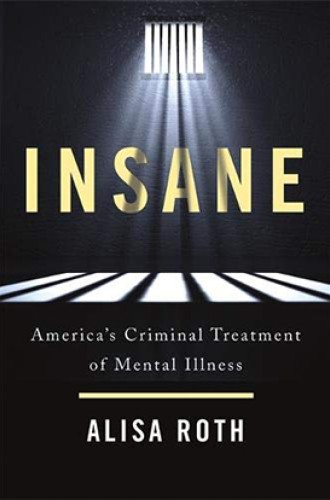From the psych hospital to the jail
Two new books provide a devastating vision of America’s mental health crisis.
Depictions of mental illness and mental health care in literature and film tend to paint a gruesome picture. Patients are often shown being treated harshly by medical staff and living in squalor, controlled by heavy doses of medication and straitjackets. Journalistic reporting on psychiatric hospitals has proven such depictions accurate. Although One Flew over the Cuckoo’s Nest–style psychiatric hospitals have largely disappeared, the question remains: What happened to their patients?
It would be comforting to believe that the closure of many psychiatric hospitals reflected an increase in acceptance and empathy for people with severe mental illness and that those patients now fare better. But that is not the case. Alisa Roth shows that prisons and jails have largely filled the void left by psychiatric hospitals, noting that as many as one in two Americans with severe mental illness will be arrested at some point in their lives. Further, Roth reports, as many as 75 percent of incarcerated women, 60 percent of men in jails, and 55 percent of men in prisons experience mental illness.
Read our latest issue or browse back issues.
Roth documents the often brutal experiences of inmates with mental illness through her visits to many of America’s largest correctional facilities, including Riker’s Island Jail, Cook County Jail, and Los Angeles County Jail. She finds inmates wearing putatively indestructible “suicide gowns” to prevent them from crafting nooses from their clothing, inmates who smeared their cells with feces and were left to live in the mess, and inmates in need of mental health care who did not receive it due to overcrowding or a lack of guards available to escort them to appointments. Many of the inmates she profiles have been abused by guards or engaged in gruesome acts of self-harm, either with their own hands or crude weapons fashioned from seemingly harmless objects. Roth reports that guards often carry knives specially designed to cut down inmates who have hanged themselves.
Some attempts have been made to rectify the situation. Roth discusses a jail diversion program run by Judge Steve Leifman in Miami-Dade County that has placed approximately 4,000 people with mental illness into treatment rather than correctional facilities. She also reports on crisis intervention training, which has been adopted by police departments in several cities across the country to help officers assist in mental health crises and prevent people with mental illness from being arrested inappropriately.
But even with these hopeful measures, the overall picture Roth presents is bleak. Though her reporter’s prose is sometimes terse and clinical, the work gets under your skin. Insane pulls no punches, and many of its anecdotes and descriptions are extremely difficult to read. At several points, I needed to take a break from the book, only to be haunted for the rest of the day by the people I’d read about. Even the overall redundancy of many of the stories Roth tells proves effective: it shows the ubiquity of criminalization and the ease with which mental illness can wreak havoc in any family. The book also underscores the radical shift required to make any significant change to public policy. Insane gives a heartbreaking and essential understanding of these issues and sheds unflinching light on their consequences.
A Court of Refuge, written by Judge Ginger Lerner-Wren (with Rebecca A. Eckland), makes an excellent companion to Insane. Lerner-Wren’s perspective reinforces and personalizes Roth’s conclusions, and the court she presides over provides a potential solution to the problems Roth identifies.
Based in Broward County, Florida, Lerner-Wren’s mental health court serves defendants with mental illness who have been charged with misdemeanor offenses. While the mental health court is voluntary, participants avoid the criminal justice system by working with the judge and social workers to gain access to much-needed resources.
As she tells the stories of the people whose cases she has presided over, Lerner-Wren discusses her desire to create a “court of refuge,” where justice is therapeutic and restorative rather than simply punitive. It’s an effort that seems to be effective in the wide variety of cases presented, from an elderly woman with schizophrenia whose loving and attentive family struggled to keep her from committing minor thefts to a deeply depressed man who was facing homelessness. Particularly affecting is the story of a woman whose mental illness became so severe that her husband took out a restraining order to keep her away from their children. Through the interventions of Lerner-Wren’s court, the woman was placed in an assisted-living facility and reestablished a good relationship with her children.
For many court participants, there is no other option if Lerner-Wren’s interventions fail. Without the court, many participants would become homeless or end up in jails or prisons—all dangerous situations for those made vulnerable by mental illness. Lerner-Wren details some of the court’s failures, including a man who was found dead of an overdose on a park bench and another who, despite initial progress, committed another crime and was arrested. Her court is unable to prevent people with mental illness from being arrested or committing crimes in the first place. That’s a larger challenge for the mental health care system.
Lerner-Wren’s tone is often hopeful, almost to the point of being saccharine, and it’s hard not to wonder how many stories of failure have been left out. The book is noticeably lacking in statistics. It only claims to be a collection of stories, not a formal report on the court’s impact. That omission makes evaluating the relative success of Lerner-Wren’s court difficult. Yet the hope she offers and the optimism she brings to her project may be necessary in her work. Lerner-Wren leaves readers feeling that the problem of criminalized mental illness can be surmounted. That’s not something that should be dismissed.
Taken together, these two books provide a devastating—but not hopeless—vision of America’s mental health crisis.








